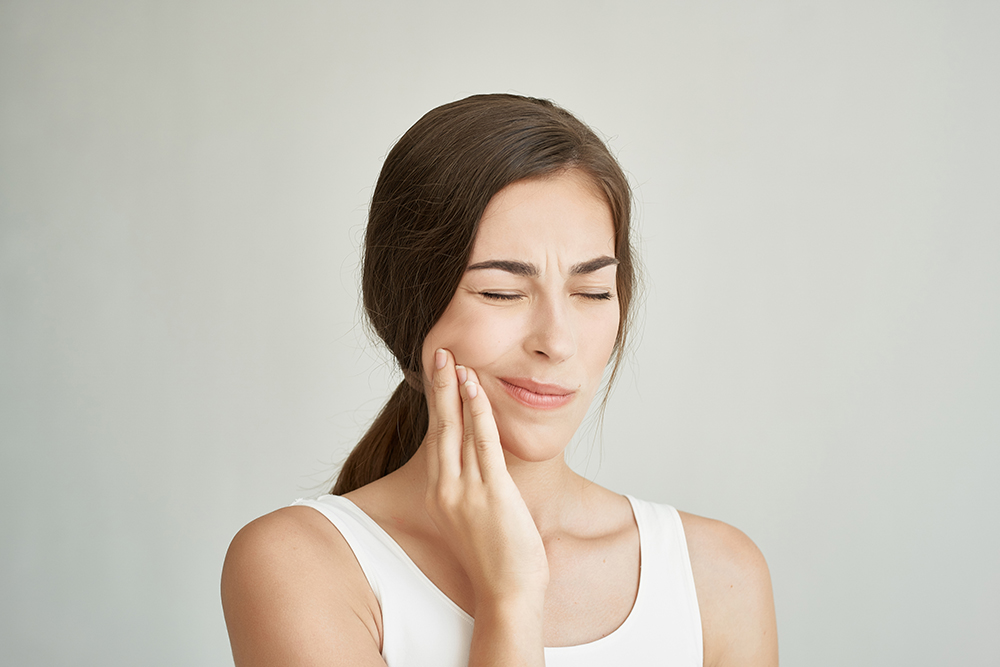Contents
Your temporomandibular joint (TMJ) is the hinge joint that connects your jawbone to your skull. It allows you to do essential activities like chewing, talking and yawning. One of the most used joints in your body, it opens and closes between 1,500 to 2,000 times daily. This complex joint is made up of muscles, ligaments and a disc that work together to help ensure smooth jaw movement. When there is an issue affecting the TMJ, it is called TMJ dysfunction. Up to 12% of the general adult population has some kind of TMJ disorder. TMJ dysfunction is twice as common in women than it is in men. Symptoms of TMJ dysfunction can manifest in a variety of ways:
- Jaw tenderness or pain.
- Pain in one or both temporomandibular joints.
- Stiffness or limited range of motion in the jaw.
- Difficulty or pain while chewing or biting.
- Pain or discomfort when yawning, talking or laughing.
- Facial pain or discomfort.
- Clicking, popping or grinding sounds when moving the jaw.
- Feeling of fullness or aching in the ears.
- Headaches.
- Tinnitus.
- Dizziness or vertigo.
- Facial swelling or inflammation.
- Changes in teeth alignment or bite pattern.
It’s important to note that not everyone with a TMJ dysfunction will experience all of these symptoms, and the severity can vary. Symptoms can come and go over time.
If you are experiencing persistent or severe symptoms of TMJ dysfunction, you should be evaluated and be treated by a qualified health care professional who specializes in TMJ disorders, such as a dentist, oral surgeon or physical therapist.
Can physical therapy help ease TMJ discomfort?
If you’re experiencing TMJ dysfunction symptoms, you’re sure to be looking for a way to achieve lasting relief. If you are thinking of giving physical therapy a try to help ease your symptoms, you will be happy to learn that physical therapy can be an incredibly beneficial treatment for TMJ dysfunction symptoms. Physical therapy can help by:
- Reducing pain.
- Improving jaw mobility.
- Boosting circulation to help promote healing.
- Helping you learn how to minimize TMJ dysfunction flare-ups.
What are the culprits behind TMJ dysfunction symptoms?
TMJ dysfunction symptoms can be caused by a variety of issues:
- Teeth grinding or clenching.
- Stress.
- Muscle tension.
- Blow to the face.
- Jaw dislocation.
- Whiplash injury.
- Osteoarthritis.
- Misalignment.
- Poor posture.
- Genetics.
- Overuse (eating or chewing food that is too hard or chewy).
Physical therapy treatments for TMJ dysfunction
Physical therapy can help combat the pain and limitations caused by TMJ dysfunction with a variety of techniques. Techniques your physical therapist may use in your personalized treatment plan include:
- Manual therapy — Manual therapy involves many hands-on techniques that can help address muscle tension, joint mobility and alignment issues in the TMJ. Physical therapists with a Certification in Orthopedic Manual Physical Therapy (COMT) have advanced training in manual therapy techniques specific to musculoskeletal conditions. This advanced training allows them to provide specialized care for people dealing with TMJ dysfunction. They can create a tailored treatment plan for your unique needs and symptoms, using evidence-based manual therapy interventions such as:
- Trigger point therapy — Trigger points are tiny knots in your muscles. These knots can be a major source of TMJ pain. Your physical therapist can use trigger point therapy with their fingers to locate these tiny knots. Once found, they can apply direct pressure or specific techniques intended to help deactivate these trigger points. This can help interrupt pain signals sent to your brain, reducing discomfort and promoting muscle relaxation.
- Joint mobilization — Your physical therapist may use joint mobilization, which involves gentle, controlled movements applied to your jaw joint. These movements can help increase your range of motion so the joint can move more freely and have reduced pain and stiffness.
- Soft tissue manipulation — Tight muscles around your jaw can contribute to pain and limited movement. Soft tissue manipulation can help relax these muscles. This muscle relaxation can help improve flexibility and reduce tension that may be pulling on your joint.
- Therapeutic exercises — Your physical therapist can design a personalized exercise program to meet your specific needs and empower you through movement. These exercises can target the muscles supporting your jaw joint. They can help strengthen these muscles and improve your range of motion. A stronger jaw can have better stability with a lower risk for future troubles.
- Ultrasound therapy — Ultrasound therapy uses sound waves to penetrate deep tissue around your TMJ. These sound waves create a gentle vibration that can stimulate circulation to promote healing of any microtears or tissue damage that may be contributing to your pain. It can also help reduce inflammation, which can reduce pain and stiffness.
- Electrical stimulation — Electrical stimulation uses low-level electrical currents that are delivered near or around the affected area by electrodes placed on the skin. These low-level currents can gently stimulate the tight muscles to help promote relaxation. It can also help retrain weak or imbalanced muscles. Electrical stimulation can help decrease pain signals that are sent to your brain. This can help you manage your pain and improve your muscle function around your TMJ.
- Postural instruction — Your physical therapist can assess your posture and identify any imbalances that may be contributing to your TMJ dysfunction. They can then help you improve your body mechanics (e.g., rounded shoulders or a hunched back) to help take stress off your jaw joint. Better overall body mechanics can help ensure that your jaw is positioned correctly and working optimally. Bad posture can lead to muscle tension. Postural instruction techniques can help loosen these tight muscles, including the tense muscles in your jaw.
Address your TMJ dysfunction with Lattimore PT
Don’t let TMJ dysfunction hold you back from enjoying life’s delicious meals or engaging in conversations. Lattimore PT is here to help you conquer TMJ pain. Our expert team of physical therapists includes over 30 COMTs across our clinics, making us the best care in town for personalization. We can help you uncover the root cause of your discomfort and empower you with strategies to manage your TMJ health.
Contact our team today for more information or to schedule an initial appointment.



